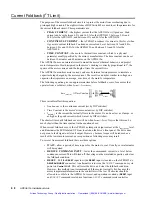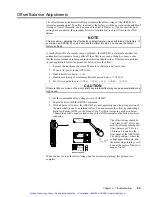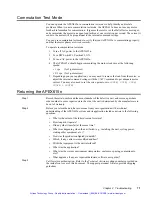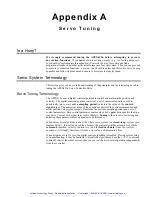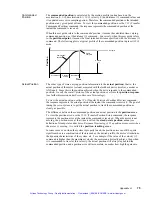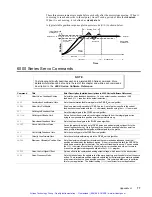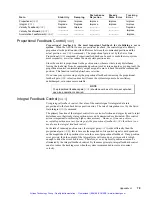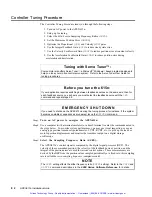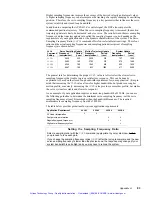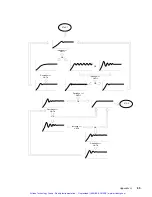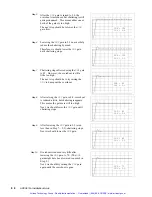
Appendix A
8 1
Velocity Feedforward Control (
SGVF
)
The purpose of velocity feedforward control is to improve tracking performance—that is,
reduce the position error when the system is commanded to move at constant velocity. The
tracking error is mainly attributed to three sources—friction, torque load, and velocity feedback
control (
SGV
).
Velocity feedforward control is directed by the Servo Gain Velocity Feedforward (
SGVF
)
setting, which is in turn multiplied by the rate of change (velocity) of the commanded position
to produce the control signal. Consequently, because the control signal is now proportional to
the velocity of the commanded position, the APEX615n essentially anticipates the commanded
position and initiates a control signal ahead of time to more closely follow (track) the
commanded position.
Applications requiring contouring or linear interpolation can benefit from improved tracking
performance; however, if your application only requires short, point-to-point moves, velocity
feedforward control is not necessary.
Because velocity feedforward control is not in the servo feedback loop (see Servo Control
Algorithm drawing above), it does not affect the servo system’s stability. Therefore, there is
no limit on how high the velocity feedforward gain (
SGVF
) can be set, except when it
saturates the control output (tries to exceed the APEX615n’s analog control signal range of
±
10V).
Acceleration Feedforward Control (
SGAF
)
The purpose of acceleration feedforward control is to improve position tracking performance
when the system is commanded to accelerate or decelerate.
Acceleration feedforward control is directed by the Servo Gain Acceleration Feedforward
(
SGAF
) setting, which is in turn multiplied by the acceleration of the commanded position to
produce the control signal. Consequently, because the control signal is now proportional to
the acceleration of the commanded position, the APEX615n essentially anticipates the velocity
of the commanded position and initiates a control signal ahead of time to more closely follow
(track) the commanded position.
Same as velocity feedforward control, this control action can improve the performance of linear
interpolation applications. In addition, it also reduces the time required to reach the
commanded velocity. However, if your application only requires short, point-to-point moves,
acceleration feedforward control is not necessary.
Acceleration feedforward control does not affect the servo system’s stability, nor does it have
any effect at constant velocity or at steady state.
Artisan Technology Group - Quality Instrumentation ... Guaranteed | (888) 88-SOURCE | www.artisantg.com


